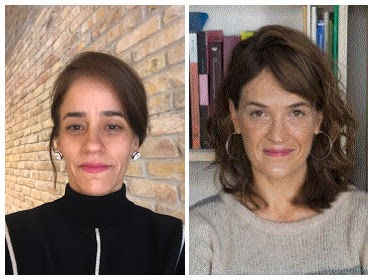The types of violence LGBTI people experience in prisons
- Human rights in Context

- Apr 14, 2023
- 7 min read
Updated: Jul 20, 2023
Evidence from Latin America and the United States

Ms Angélica Arámbulo
Angélica Arámbulo holds an M.A. in Development Studies (Major in human rights, gender and conflict studies) and a specialization in Peace and Conflict Studies from the International Institute of Social Studies of Erasmus University. She has experience as a researcher and consultant for projects associated with the reintegration of former combatants in Colombia, social justice and gender equality. All her views are personal.
Introduction
Historically the Lesbian, Gay, Bisexual, Transgender and Intersex LGBTI community ( I will use the acronym LGBTI instead of LGBTQIA+ since is the most used term in the reviewed literature) has faced multiple forms of discrimination and the violation of their human rights. Despite some progress that has been made in the last century, LGBTI people are still stigmatized based on their sexual orientation and gender identity. Only in 2016, the United Nations Humans Rights Council issued a special mandate to establish an independent expert on sexual orientation and gender identity to “explore ways to better protect persons who suffer from violence and discrimination”.
In the case of the LGBTI population serving time in prison, protecting their human rights seems to be even more precarious and with fewer guarantees. In 1988, the United Nations (UN) established the “Body of Principles for the Protection of All Persons under Any Form of Detention or Imprisonment” to protect the human rights of people while in prison. Nevertheless, the UN has not issued a specific international instrument for the protection of LGBTI persons who are deprived of their liberty. This is concerning, especially considering that currently around 69 State members of the UN still enforce laws that deny the full enjoyment of human rights to LGBTI people, despite being committed to protecting and promoting human rights under international human rights law.
This entry will focus on the needs and challenges LGBTI people face in Latin America and the United States. It will pay special attention to the Transgender population, which remains one of the most marginalized populations outside and inside prisons. I will use the concepts of direct and structural violence by Johan Galtung: a) Direct violence refers to visible behaviours which intend to hurt someone on a physical or psychological level, and b) structural violence is a form of invisible violence through which a social institution limits people’s ability to meet their basic needs.
The first concept helps us understand the more visible forms of violence LGBTI people are exposed to in and out of prisons, but also the structural types of violence which can make them more likely to end up in prison in the first place. Furthermore, prisons are organized in such a way that exacerbates the structural violence LGBTI inmates are typically exposed to throughout their lives.
Social stigma
The LGBTI population usually starts experiencing discrimination from a young age. The first place where they encounter discrimination is commonly within the family since there is typically a lack of acceptance of their identity and sexual orientation. This translates into domestic violence and homelessness, especially for transgender people who are less accepted. The second places, where young LGBTI people face physical and psychological violence are their close community and school. Therefore, LGBTI persons have a higher chance of dropping out of school and ending in a situation of poverty from a very young age.

Limited access to education and employment leaves the LGBTI population with few livelihood opportunities. As a result, many of them become involved in criminal activities such as sex services, drug dealing, and prostitution, increasing their chances of ending up in prison later. The incarceration of LGBTI people is also a result of police prejudice.
This means being targeted not only for criminal activity but also for factors related to gender and sexual orientation, class, and race. Donohue's (2021) studies indicate that once an LGBTI person enters prison, they are more likely to experience violence and discrimination based on their gender and sexual orientation. Several authors view prisons as social institutions that reinforce gender binary structures and patriarchal structures where heterosexism becomes the norm and a strategy to enforce power. For example, in the United States and most prisons around the world, the housing of inmates is determined by the sex assigned at birth instead of gender identity. This already establishes structural violence grounded on segregation towards a population who do not identify themselves based on their genitalia. Predominantly transgender people are more vulnerable to experiencing a higher risk of victimization and marginalization since they do not belong to a socially recognizable category.
Segregation is reinforced inside the prison through systematic bias, social rejection, homophobia, and transphobia by other prisoners and prison staff. For example, LGBTI inmates in the United States and Latin America have reported experiencing limited access to basic services related to health, mental health, safety, and rehabilitation. This shows that prejudices and biases are rooted in the way prisons are organised and in the people who are part of them, contributing to dynamics of exclusion and denying LGBTI people access to human rights related to basic needs.
Safety and survival
LGBTI people in prisons encounter direct violence and suffer from different types of abuse: sexual violence, psychological violence, physical violence, harassment, bullying, and verbal abuse, among others. To survive, the LGBTI population adopts heteronormative and traditional behaviours associated with feminine and “appropriate behaviours”. For example, gay men end up doing tasks such as washing the clothes of other inmates or cleaning up the cells of inmates who hold power positions inside prison. It is also common for transgender gay women to change their sexual preference and become involved in heterosexual relationships in search of some sort of protection. Violence is even higher for transgender women who are assigned to male prisons. They suffer physical violence (e.g., being beaten up, sexually abused, or becoming servants) perpetrated by other inmates and prison staff. For example, a transgender woman in an American prison reported: “I have been beaten and raped because of me being a transgender with female breasts and feminine”. In her case, there were no consequences for the inmates who abused her and for the prison staff that did not intervene to prevent it.
In another case, a transgender woman in a Mexican male prison reported that “guards practised sexual violence and forced them into prostitution, threatening to send them to isolation cells or to the blocks with the worst reputation for violence”.
Prisons are social institutions where direct violence is promoted based on social stigma. Moreover, prison inmates and staff tend to exclude the LGBTI population based on their prejudices, often through violent means. All of the above points to the violation of the human rights of people who do not conform to binary and heteronormative structures in prisons. As such, it could be argued that the LGBTI people inside prisons are not seen as human beings or even full citizens worthy of the most basic dignity.
Access to healthcare services
Social stigma and discrimination faced by the LGBTI population in prison interfere with their access to health and mental health services. They experience more discrimination and victimization if they suffer from a medical condition (e.g. HIV positive, STDs, disabilities) before entering prison because they are less likely to receive the treatments they need to stay healthy. Additionally, in general, prisons do not have a gendered approach to health interventions, leaving LGBTI inmates without proper health care and support.
Prisons also failed to develop inclusive and adequate health care for the transgender population that presents specific needs and requires particular medical care. They rarely receive hormone and gender-affirming treatments, which result in negative impacts on their physical and mental health. Additionally, LGBTI inmates’ mental health can deteriorate because of multiple forms of oppression and violence. Some of the psychological symptoms associated are anxiety, depression, fear, suicidal ideations, and post-traumatic stress disorder, among others.
The LGBTI population often experience traumatic events before entering prison: most of them have gone through the process of ‘coming out’, experiencing both the negative and positive aspects of expressing their gender identity. However, once they enter prison a reverse process occurs where their capacity to express their gender identity and sexual orientation is often severely constrained. Prison essentially becomes a form of structural violence, based on a set of heteronormative values and norms assumed by prison staff and inmates. This further legitimizes the use of direct violence by denying the LGBTI population access to healthcare and the fulfilment of basic needs. In short, one form of violence feeds into the other through a reinforcing, circular dynamic.
Conclusions
The LGBTI people encounter direct and structural violence in prisons through three categories: social stigma, safety and survival, and access to health care services. Before entering prison LGBTI people are already subject to direct and structural forms of violence that make them more vulnerable to engage in criminal activities. Prisons are per se places where heteronormative norms and structures are reinforced rather than challenged, leading to the further exclusion of the incarcerated LGBTI community. During their time in prison, LGBTI people have only limited access to the very specific mental and physical healthcare services that they require. Further research should focus on the specific needs and vulnerabilities of LGBTI people in prisons, specifically in Latin America where our understanding is particularly limited. This will help to develop better-informed policies aimed at eliminating discriminatory practices against LGBTI inmates, by putting forward gender-inclusive approaches and programs tailored to their needs. This can potentially help guarantee their human rights and give them more chances of being reintegrated into society when released from prison.
The Human Rights in Context Blog is a platform which provides an academic space for discussion for those interested in human rights, democracy, and the rule of law. We are always interested in well-written and thoughtful comments and analyses on topical events or developments. Scholars from all disciplines, students, researchers, international and national civil servants, legislators and politicians, legal practitioners and judges are welcome to participate in the discussions. We warmly invite those interested in writing a post to send us an e-mail explaining briefly the relevance of the topic and your background as an expert. We will get back to you as quickly as we can. All contributors post in their individual capacity, and their opinions do not necessarily reflect the official position of Human Rights in Context, or any organisation with which the author is affiliated.


